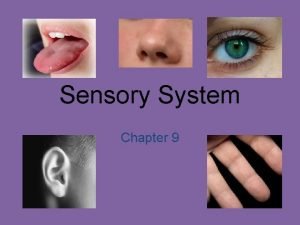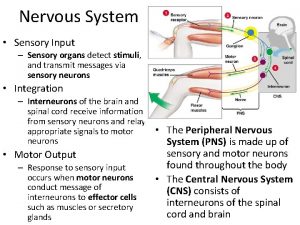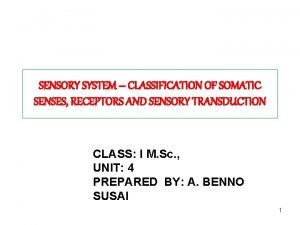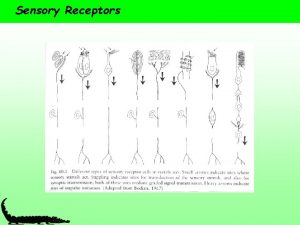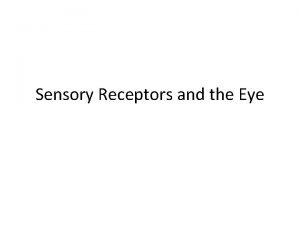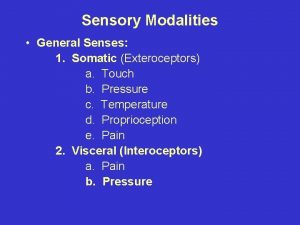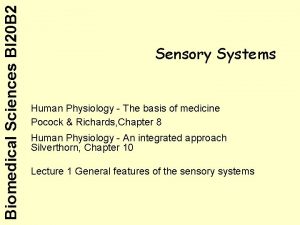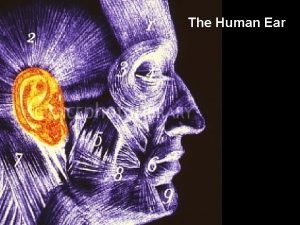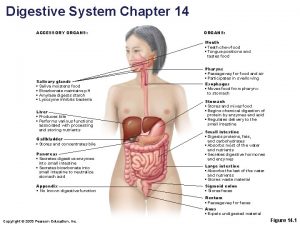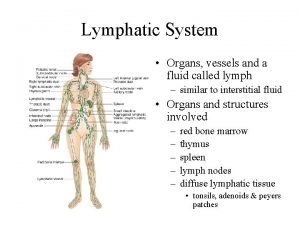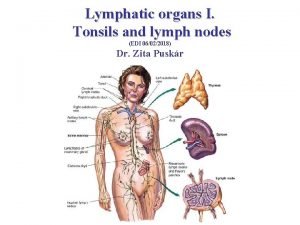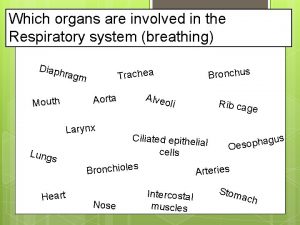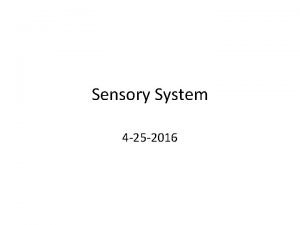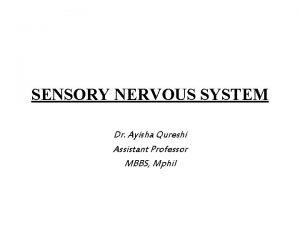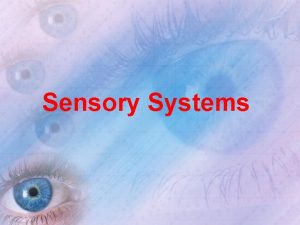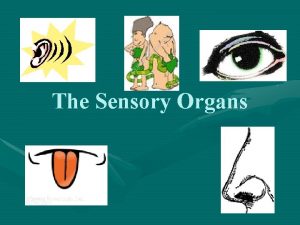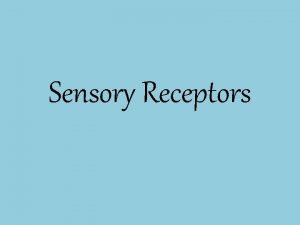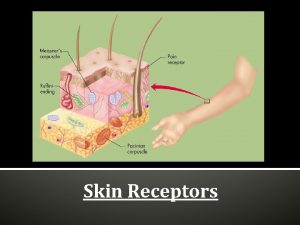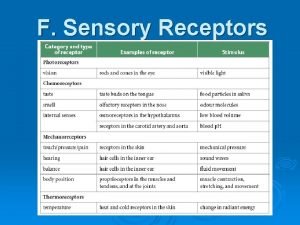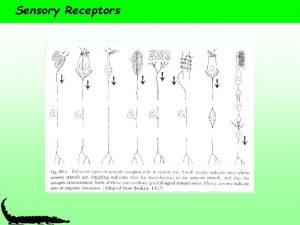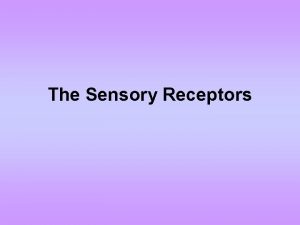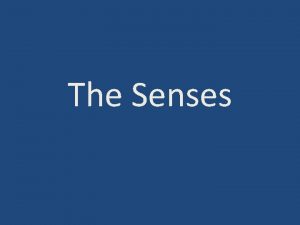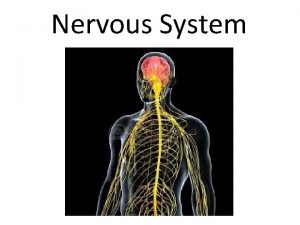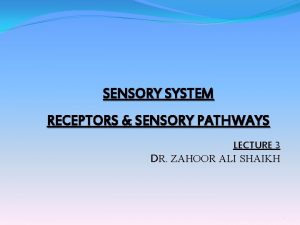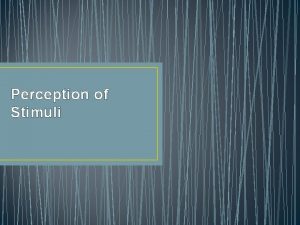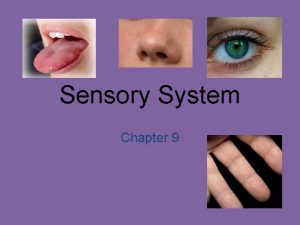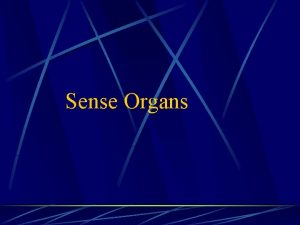Nervous System NERVOUS SYSTEM Sensory organs receptors capture




































- Slides: 36

Nervous System

NERVOUS SYSTEM Sensory organs (receptors) capture information from the body and the environment, and then transmits it to the nervous system, which receives and processes the information thus generating responses. These responses are transmitted by nervous impulses to effectors, which execute these responses.

Nervous system functions. - Receives information perceived by the sensory organs. - Interprets the information. - Produces appropriate responses. - Transmits the necessary orders to the effectors. - Coordinates the operation of every organ in our body. - Makes intellectual and mental decisions. - Is responsible for emotions and feelings.

Brain Neuron Fibres Spinal Cord

NEURONS AND NERVE IMPULSES Neurons have a unique ability: to generate and transmit nerve impulses (currents). When a neuron is stimulated it triggers electrical changes in the cell membrane that are transmitted from dendrites to the axon. The connection established between neurons is called synapse. Synapses are points of control of the transmission of nerve currents. They allow the nerve impulses to pass from one neuron to the other through certain areas. There is a narrow space between neurons known as a synaptic gap or cleft. At the end of the axon there are very small vesicles that contain substances called neurotransmitters.

-Axon is a long, thin fiber that carries nerve impulses. - - Dentrites are thin extensions of the cell body that carry nerve impulses towards the cell body.


According to their function Neurons can be: - Sensitive. Transmit the information from the receptors to the major nervous centers. - Motor. Transmit orders to the effectors. - Intercalary. Located between sensory and motor neurons. They are located on the higher nervous centers. They run between and connect two other neurons.

The Cerebro-spinal nervous system regulates and coordinates the relations between the organism and the external environment. It is made up of the Central Nervous System (CNS) and the Peripheral Nervous System (PNS).


PERIPHERAL NERVOUS SYSTEM (PNS) The peripheral nervous system connects the sensory organs to the central nervous system, and the central nervous system to the effectors. It is made up of nerves, which are kinds of cords made up of several associated axons.

CENTRAL NERVOUS SYSTEM (CNS) The central nervous system consists of the spinal cord and the brain, which are the centers that receive, integrate, and process information. The central nervous system is protected from accidental external injury by: - The skull and the vertebral column (spine or back bone) - Three membranes called meninges. The cerebrospinal fluid fills the space between the meninges. In the central nervous system there are two different areas: - White matter - Grey matter


THE BRAIN The brain is the part of the central nervous system housed inside the skull. The brain is divided up into four parts: - The medulla oblongata. Is an extension of the spinal cord. - The brain stem. Includes several parts of the brain, located between the medulla and the brain. - The cerebellum is located at the back of the brain. - The cerebrum is the biggest and most important organ of the nervous system. The cerebrum consists of inner white matter, and outer grey matter that is the cerebral cortex.

There are two types of folds on the cerebrum surface: • Gyri (circumvolutions). Are numerous and shallow folds. • Sulcus (fissures). Are rare and deep folds. One of the sulcus divides the brain into two hemispheres (right and left), which are connected by the corpus callosum. The remaining fissures and gyri define different areas of the cerebral cortex, known as lobes. The left hemisphere is logical and analytical. The right is intuitive and creative.


THE FUNCTIONS OF THE BRAIN. - Receives information from all sensory organs and produces the corresponding sensations. - It processes the information received and prepares responses and orders for the effectors. - Coordinates and controls the operation of all parts of the nervous system. - hosts the intellectual faculties and higher nervous system functions.

THE SPINAL CORD The spinal cord is a nerve cord that runs inside the channel formed by the spine. The functions of the spinal cord are: - Carries out reflexes. - Conducts sensory impulses to the brain, and the motor commands from the brain to the effectors.

Types of nerves as related to their origin in the NCS: -Cranial nerves. They come from the brain. - Spinal or spinal nerves. They come from the spinal cord. A few small lumps called ganglia are observed In the trajectory of certain nerves.


The axons are electrically isolated by the myelin sheath. This prevents against the passage of the nervous current between different axons. Types of nerves as related to the way they transmit the nervous impulse: - Sensory nerves. Transmit information from the sensory organs. - Motor nerves. Send commands to the effectors. - Mixed nerves. Contain both types of axons.

NERVOUS ACTS -Reflex actions. They are fast and automatic acts in which the brain does not participate. The three types of neurons (sensory, motor and intercalary) are involved in reflex actions. - Voluntary actions, in which the brain does participate.

AUTONOMIC NERVOUS SYSTEM (ANS) The autonomic nervous system, also known as visceral or involuntary, is responsible for the proper regulation and coordination of internal organs. There are two types of autonomic nervous systems: - Sympathetic. It induces the body organs to work more intensively (activation). - Parasympathetic. It’s action causes relaxation and slower and less intense performance of the organs (inactivation).

NERVOUS SYSTEM DISEASES

DEMENTIA Dementia is an impairment in memory and long-term problems associated with abstract thinking and other disorders of brain function and personality changes. The disorder is severe enough to significantly hamper the ability to perform routine activities.

ALZHEIMER Alzheimer's Disease is a degenerative brain disease for which there is no cure. Slowly and inexorably, the disease attacks nerve cells in all parts of the brain's cortex, as well as some surrounding structures, thereby impairing the person's abilities to govern emotions, recognize errors and patterns, coordinate movement, and remember. In the end, the afflicted person loses all memory and mental functioning.


EPILEPSY Epilepsy is a physical condition that occurs when there is a sudden, brief change in the brain. When brain cells are not working well, consciousness, movements or actions of one person can be altered for a short period of time. These physical changes are called epileptic seizures.


PARKINSON’S DISEASE It is a neurological disease that is associated with muscle rigidity, difficulty walking, tremors and impaired movement and coordination. Parkinson's disease is a chronic neurological process which causes progressive alteration in the substantia nigra of the midbrain (areas that control and coordinate movements), and the decline of brain dopamine. Dopamine is a neurotransmitter substance that transmits nerve impulses to other cells.


DEPRESSION People affected by this disorder undergo anxiety, sense of failure and loss of interest in most things. Depression can be developed by external circumstances, such as bereavement, or by internal unknown causes.


HEALTHY HABITS - Conduct an orderly life and regular schedules with time for rest and recreation. - Do not use drugs. - Exercise by doing continuous intellectual and mental activities to encourage proper maintenance of nerve function. - Make sure your diet contains sufficient vitamins for an optimal functioning of the nervous system. - Avoid stress. - Be critical aware of advertisements that are not suitable for nervous and emotional stability.


CREDITS -Patricia Rodríguez Torner -Rocío Mendoza López -Sara Sánchez Romero -Tania Romero Caña
 Sensory system organs
Sensory system organs Organs of the sensory system
Organs of the sensory system Classification of somatic senses
Classification of somatic senses Sensory receptors in vertebrates
Sensory receptors in vertebrates Classification of sensory receptors
Classification of sensory receptors Exteroceptors
Exteroceptors Exteroceptors examples
Exteroceptors examples Classification of sensory receptors
Classification of sensory receptors Nerves
Nerves Sensory receptors
Sensory receptors Sensory receptors
Sensory receptors Supporting cells
Supporting cells Label the different types of neuronal pools in the figure.
Label the different types of neuronal pools in the figure. Sensory input and motor output
Sensory input and motor output Neuronal processes
Neuronal processes Knowledge capture system
Knowledge capture system Dissected kidney
Dissected kidney Major and accessory organs of the digestive system
Major and accessory organs of the digestive system Accessory organs of the digestive system
Accessory organs of the digestive system Major and accessory organs of the digestive system
Major and accessory organs of the digestive system Lymphatic and urinary system
Lymphatic and urinary system Formation of lymph
Formation of lymph Lymphatic tissue
Lymphatic tissue Function of lymphatic system
Function of lymphatic system Which organs are involved in respiratory system
Which organs are involved in respiratory system Chapter 13 respiratory system
Chapter 13 respiratory system Endocrine
Endocrine Nervous system and digestive system
Nervous system and digestive system Endocrine system and nervous system
Endocrine system and nervous system Nervous system vs endocrine system venn diagram
Nervous system vs endocrine system venn diagram Adh function
Adh function Tuberous receptors
Tuberous receptors Olfactory receptors
Olfactory receptors Difference between alpha and beta receptors
Difference between alpha and beta receptors Umami taste receptors on tongue
Umami taste receptors on tongue Merkel cells
Merkel cells 3 types of lung receptors
3 types of lung receptors
